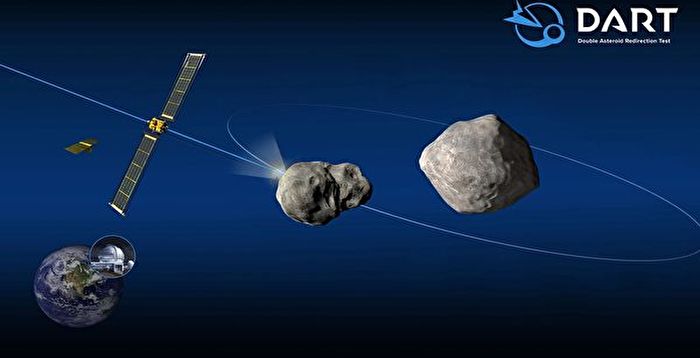[Epoch Times, September 27, 2022](The Epoch Times reporter Takasugi compiled a report) On Monday (September 26), a NASA spacecraft was crashing into a person at an extremely fast speed. asteroid. This is an unprecedented exercise to “defend the earth” in order to face the deadly threat of “asteroid hitting the earth” in the future.
This “home run” in the Milky Way will be carried out against a harmless asteroid 7 million miles (about 9.6 million kilometers) away. A NASA spacecraft called Dart will crash into the space rock at 14,000 miles per hour (22,500 kilometers per hour).
Scientists expect the impact to carve a crater in the asteroid and toss a stream of space rock debris and rubble into space. And most importantly, the impact will change the asteroid’s orbit.
Telescopes around the world and in space are gearing up to capture this historic moment. The impact of the impact should be immediately visible — the Dart spacecraft’s radio signal would suddenly stop — so it will take days or even weeks to determine if, and by how much, the asteroid’s path has been changed time.
The $325 million mission is the first attempt by humans to alter the flight path of an asteroid in space, or the position of any natural object in space.
NASA Administrator Bill Nelson tweeted earlier in the day, “No, this is not a movie plot.” In a pre-recorded video, he said: “We are all in Armageddon. ) I’ve seen this scene in movies like this, and in real life it’s very likely to happen.”
The target of Monday’s space experiment was a 525-foot (160-meter) asteroid called Dimorphos. It’s actually a small satellite of Didymos, which is five times larger. Didymos, which means “twin” in Greek, is a rapidly spinning asteroid that ejected material to form the little companion.
The pair of asteroids and moonlets have orbited the sun for centuries without threatening Earth, making them ideal test subjects for humanity’s first “save the world” experiment.
Launched last November, the vending machine-sized “Dart” spacecraft — also known as the “Double Asteroid Redirection Test” for short — uses a spacecraft developed by Johns Hopkins University. Apply new navigation techniques developed in the physics lab to track targets. The lab is the builder and mission manager of the Dart spacecraft.
In the experiment, another tiny satellite will fly by a few minutes later to take pictures of the impact. Two weeks ago, an Italian Cubesat satellite was released from the Dart.
Scientists insist the Dart spacecraft won’t shatter the tiny moon Dimorphos. The spacecraft weighs just 1,260 pounds (570 kilograms), while the asteroid weighs 11 billion pounds (5 billion kilograms). But that should be enough to shrink its 11-hour, 55-minute orbit around Didymos’ star.
The impact should shorten the orbit by 10 minutes, but the telescope will take anywhere from a few days to nearly a month to verify the new orbit. The scientists noted that the expected 1 percent orbital shift might not sound like much. But they stress that, years later, it will be a huge change.
Planetary defense experts prefer to push a threatening asteroid or comet out of the way with sufficient preparation time, rather than blowing it up and producing multiple pieces that could continue in orbit and land on Earth.
Dealing with large space rocks may require multiple impactors, or a combination of impactors and so-called gravity tractors. A gravity tractor is a yet-to-be-invented device that uses its own gravity to pull asteroids into orbits that are safer for Earth.
“The dinosaurs didn’t have a space program to help them know what was going to happen, but we did,” said Katherine Calvin, NASA’s senior climate adviser, referring to the 66-million-year-old dinosaur mass extinction event. The dinosaur mass extinction is believed to have been caused by a large asteroid hitting Earth, a volcanic eruption, or both.
The B612 Foundation, a non-profit organization, has been working on research to protect Earth from asteroid impacts. The group has been promoting experiments like the Dart spacecraft hitting space rocks since it was founded by astronauts and physicists 20 years ago.
The foundation’s executive director and former astronaut Ed Lu warned that Monday’s high-profile action aside, the world must do a better job of identifying and tracking the myriad space rocks lurking outside.
According to NASA, there are an estimated 25,000 near-Earth, lethally 460-foot-diameter asteroids, but apparently less than half have been discovered. And of the millions of smaller space rocks that can cause widespread damage, less than 1 percent of asteroids have been found.
Lu pointed out that the Vera Rubin Observatory in Chile, built by the National Science Foundation and the US Energy Department, is nearing completion, which promises to give the search for asteroids a boost. to a revolutionary change.
Finding and tracking asteroids, he said, “that’s what this mission is called and what it’s about. It’s what has to be done to protect the planet.”
Responsible editor: Ye Ziwei#
